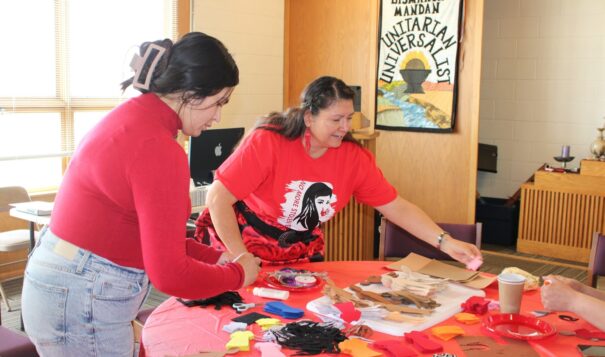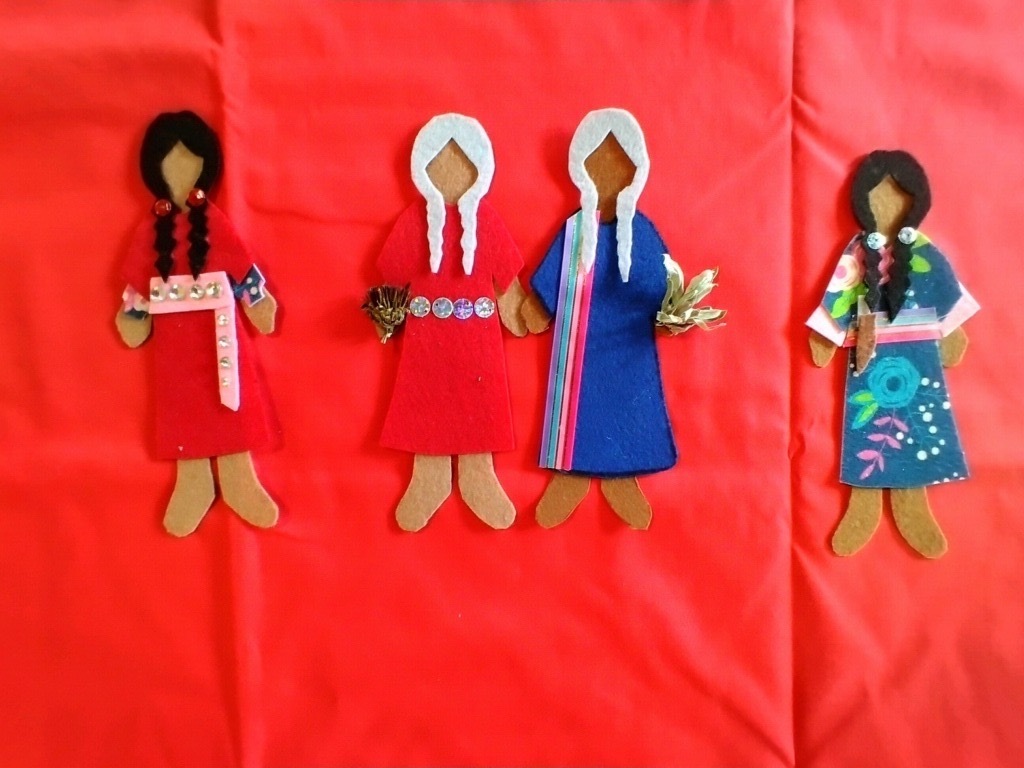News Based on facts, either observed and verified directly by the reporter, or reported and verified from knowledgeable sources.
North Dakota women launch Faceless Doll Project to honor National MMIR Day, individuals pay tribute to relatives
 Leta Killer (center) came out to the Faceless Doll Project in Bismarck on May 4 to tell the story of her two relatives who had been killed. Photo credit/ Adrianna Adame
Leta Killer (center) came out to the Faceless Doll Project in Bismarck on May 4 to tell the story of her two relatives who had been killed. Photo credit/ Adrianna Adame
Art workshop creates space for ‘family members to just exist’
Leta Killer arrived with a purpose in attending the Faceless Doll Project. The event in Bismarck, N.D. marked the National Day of Awareness for Missing or Murdered Indigenous Persons. For the first time in her life, she would share her family’s story about the crisis of violence and lost relatives in Indian Country.
The Faceless Doll Project organizers Melanie Moniz and Agnes Yellow Bear held the gathering and community art workshop with just that kind of sharing in mind. In contrast to advocacy and demonstrations typical of the national May 5 MMIP commemoration – held annually since 2017 – they said this occasion was for grieving and healing in peace.
“I think that sometimes we focus so much on awareness and the pursuit of justice, that we forget about creating the spaces that allow family members to just exist,” Yellow Bear told Buffalo’s Fire.
Dolls without facial features are symbolic in many cultures, including Indigenous tribes. The Faceless Doll Project will create a collection of felt dolls representing the Missing and Murdered Indigenous Relatives of Native families.
These dolls have no facial features to remind us to remember victims of crime, Moniz told Buffalo’s Fire. “Many of us are survivors and family members that have to go home with this,” she said. “And so, we’re not these faceless victims. Our loved ones aren’t faceless.”
Killer, Arikara and Nez Perce, made two dolls to honor her lost relatives. She recalled her grandma Norma “Babsie” Leona Charley’s death weighing heavily on her family throughout the years. Back in 1952, at age 16, Babsie, who was deaf, walked to the store alone and never returned home.
The story goes that she was beaten and sexually assaulted by five men, then left to die on the side of the road. She was clinging to life when rescued but succumbed to her injuries in the hospital.
Killer’s family soon knew the circumstances that led to Charley’s death. However, Indigenous families many times aren’t able to piece together what happens to their missing loved ones until years pass.

Such was the case of her relative Norma Leone Eagle, who went missing in 1971. A Nez Perce citizen, she had run away from an abusive adoptive home. It wasn’t until decades later that DNA testing identified her remains. Killer and her family found that she had been held in a morgue for 17,428 days in Sonoma, Calif.
Killer used two layers of felt for the doll she made representing Eagle. Nez Perce attire often involves two layers. “I made her with a shiny belt because in our beliefs we believe they go to the Milky Way, so that she’s up there shining with her family and with her brother,” said Killer.
“They buried her above the Nez Perce Museum and my cousin made a promise to always talk about her because she was away for so long and never found and that when she came home there never was a funeral so nobody could properly mourn her,” she said.
Since Eagle’s homecoming to Lewiston, Idaho. Killer said she and her mom have been working to collect enough funds to provide a gravestone memorial for her.
“From now on I want to save your names Norma “Babsie” Leona Charley and Norma Leone Eagle,” said Killer with tears. “They were both 16 years old when they died, they were both killed and they were both missing. I want to tell them, ‘We remember you. We remember you Grandma Babsie and we remember you Auntie Norma.’ They didn’t get a chance to grow up. They didn’t get a chance to have children, and they didn’t get to have a family of their own.”
The U.S. Department of the Interior has recognized the MMIP issue as a national crisis. According to the Interior website, more than 1.5 million American Indian and Alaska Native women have experienced violence in their lifetime. In a 2016 study by the National Institute of Justice, they found that more than 84% of American Indian and Alaska Native women have experienced violence in their lifetime, including 56% who have experienced sexual violence.
StrongHearts Native Helpline shared information in an email about how Native women are being murdered at a rate 10 times higher than other ethnicities. “These higher rates of violence against Native American women are in no small part due to federal law limiting tribal court’s jurisdiction to criminally prosecute non-Native people who commit crimes on tribal lands.”
Yellow Bear said she is tired of fearing for her loved ones’ safety. In the future, she wants Indigenous lives not only protected but also respected. “My hope is that our people, Indigenous people, that we don’t have to worry about our children,” said Yellow Bear. “That we don’t have to worry about our loved ones. Or have to have a fear if we know that they have to walk an extra two blocks at night.”
Killer attended a doll-making session at a Bismarck church on May 4, while a May 5 session was set up in Fargo, N.D. The organizers previously led the Walking with Our Relatives march on Orange Shirt Day on Sept. 30, 2023.
As Killer concluded by sharing her story with the doll workshop group, she said Native women must be loved, cherished, and protected.
“Women deserve to be safe and loved in a good way,” said Killer. “They deserve to grow up, have their own families, deserve to be who they were meant to grow up to be. Hopefully within their families they can help one another to keep healing and that we can make this world a better place for our future generations.”
Sourcing & Methodology Statement:
Rosay, A. B. (2016, June 1). Violence Against American Indian and Alaska Native Women and Men. National Institute of Justice. https://nij.ojp.gov/topics/articles/violence-against-american-indian-and-alaska-native-women-and-men
U.S. Department of the Interior. (n.d.). Missing and Murdered Indigenous People Crisis. Missing and Murdered Indigenous People Crisis | Indian Affairs. https://www.bia.gov/service/mmu/missing-and-murdered-indigenous-people-crisis
Dateline:
BISMARCK, N.D.
